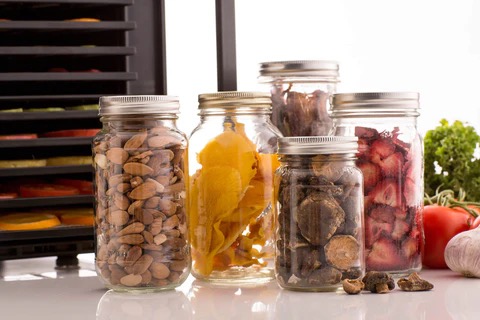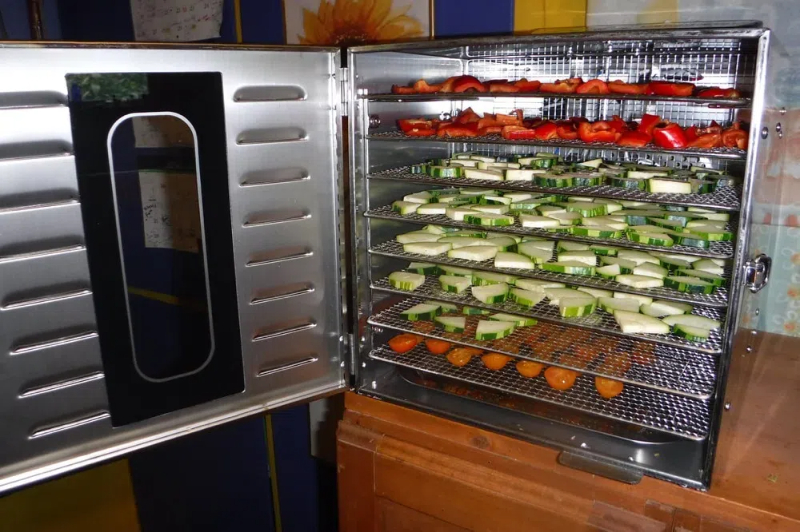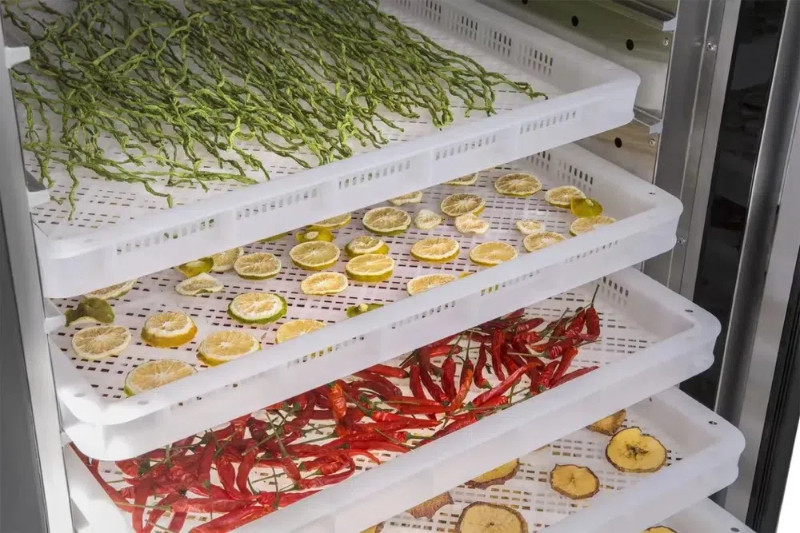
Content Menu
● Introduction
● Understanding Food Dehydration
>> The Science Behind Dehydration
>> Traditional vs. Modern Dehydration
● What is a Cabinet Type Dehydrator?
>> Key Components
>> Operational Principles
● Advantages of Cabinet Type Dehydrators
>> Superior Drying Performance
>> Enhanced Food Safety
>> Versatility
>> Energy Efficiency
>> Reduction of Food Waste
● Applications of Cabinet Type Dehydrators
>> Home Use
>> Commercial Use
>> Agricultural Use
● Types of Cabinet Dehydrators
>> Small-Scale Cabinet Dehydrators
>> Medium-Scale Cabinet Dehydrators
>> Large-Scale Cabinet Dehydrators
>> Solar Cabinet Dehydrators
● How to Choose the Right Cabinet Dehydrator
>> Capacity
>> Features
>> Energy Efficiency
>> Build Quality
>> Budget
● Best Practices for Using a Cabinet Dehydrator
>> Food Preparation
>> Loading the Dehydrator
>> Drying Process
>> Storage
● Conclusion
● FAQ
>> 1. What types of food can be dried in a cabinet dehydrator?
>> 2. How long does it take to dehydrate food in a cabinet dehydrator?
>> 3. How do I clean a cabinet dehydrator?
>> 4. Are cabinet dehydrators energy-efficient?
>> 5. Can I use a cabinet dehydrator to make jerky?
● Citations:
Introduction
In an era increasingly concerned with sustainability, reducing food waste, and ensuring access to nutritious foods year-round, innovative food preservation methods are gaining prominence. Among these, cabinet-type dehydrators stand out as efficient, versatile, and eco-friendly solutions. This article explores the benefits of cabinet dehydrators, their operational principles, and why they are an excellent choice for both home and commercial use. We will delve into the specifics of how these dehydrators work, the advantages they offer over other preservation methods, and practical tips for making the most of this sustainable technology.

Understanding Food Dehydration
Food dehydration is an age-old preservation technique that involves removing moisture from food to inhibit the growth of bacteria, yeasts, and molds. By reducing water activity, dehydration extends the shelf life of food products while retaining their nutritional value and flavor. Dehydrated foods offer a convenient way to store surplus produce, create healthy snacks, and ensure a readily available supply of essential ingredients.
The Science Behind Dehydration
Dehydration works by creating an environment where microorganisms cannot thrive. Microorganisms need water to grow and multiply. Removing water content slows down enzymatic reactions that cause spoilage, preventing the breakdown of food and preserving its quality. The process typically involves a combination of heat and airflow to evaporate moisture effectively. By controlling these two elements, we can ensure safe and effective food preservation.
Traditional vs. Modern Dehydration
Traditional methods, such as sun-drying, have been used for centuries. These methods involve spreading food items in direct sunlight to evaporate moisture. However, these methods are often unreliable due to weather conditions, potential contamination from insects and dust, and uneven drying. Modern dehydrators, particularly cabinet-type models, offer controlled environments that ensure consistent and safe drying, eliminating the drawbacks of traditional methods. This control leads to better quality, longer shelf life, and reduced risk of spoilage.
What is a Cabinet Type Dehydrator?
A cabinet-type dehydrator is an enclosed appliance designed to remove moisture from food items using controlled temperature and airflow. These dehydrators typically consist of an insulated cabinet with multiple trays or racks to hold food items. The insulated design helps maintain a consistent internal temperature, ensuring uniform drying throughout the cabinet.
Key Components
- Insulated Cabinet: Constructed from materials that minimize heat loss, ensuring efficient operation and consistent temperatures.
- Trays/Racks: Made from food-grade materials, often stainless steel or BPA-free plastic, providing a safe and hygienic surface for drying food.
- Heating Element: Provides a consistent heat source, typically electric, to warm the air inside the cabinet.
- Fan: Circulates air evenly throughout the cabinet, ensuring uniform drying across all trays.
- Temperature and Humidity Controls: Allow precise adjustment of drying conditions, enabling users to customize settings for different types of food.
- Air Vents: Regulate airflow and moisture removal, preventing condensation and ensuring efficient drying.
Operational Principles
Cabinet dehydrators operate on the principle of forced convection. A heating element warms the air inside the cabinet, while a fan circulates the warm air evenly across the trays. This process draws moisture from the food, which is then vented out of the dehydrator. Precise temperature and humidity controls ensure optimal drying conditions for different types of food. The ability to control these factors is crucial for preserving the flavor, texture, and nutritional content of the dehydrated food.
Advantages of Cabinet Type Dehydrators
Cabinet dehydrators offer numerous advantages over other drying methods, making them a popular choice for sustainable food preservation. These advantages range from superior drying performance and enhanced food safety to versatility and energy efficiency.

Superior Drying Performance
- Even Drying: Consistent temperature and airflow ensure uniform drying across all trays, preventing some areas from drying faster than others.
- Precise Control: Adjustable temperature and humidity settings allow for customized drying of various foods, ensuring optimal results for each type of food.
- Faster Drying Times: Forced convection accelerates the drying process compared to passive methods like sun-drying, saving time and energy.
Enhanced Food Safety
- Controlled Environment: Enclosed cabinet protects food from contamination by dust, insects, and other external factors, ensuring a clean and hygienic drying process.
- Consistent Results: Reliable temperature control minimizes the risk of spoilage or uneven drying, ensuring the food is properly preserved.
- Food-Grade Materials: Trays and cabinets are typically made from FDA-approved materials, ensuring food safety and preventing the leaching of harmful chemicals into the food.
Versatility
- Wide Range of Foods: Suitable for drying fruits, vegetables, meats, herbs, and more, making it a versatile tool for food preservation.
- Customizable Settings: Adjustable temperature and humidity allow for optimal drying of different food types, ensuring the best possible results for each food item.
- Commercial and Home Use: Available in various sizes to meet the needs of both small households and large-scale operations, making it accessible to a wide range of users.
Energy Efficiency
- Insulated Design: Minimizes heat loss and reduces energy consumption, making it an economical choice for long-term food preservation.
- Precise Temperature Control: Prevents overheating and wasted energy, ensuring the dehydrator operates efficiently.
- Solar-Powered Options: Some models can be powered by solar energy, further reducing environmental impact and providing a sustainable drying solution.
Reduction of Food Waste
- Extended Shelf Life: Dehydration significantly extends the shelf life of perishable foods, reducing waste and ensuring a readily available supply of essential nutrients.
- Preservation of Nutrients: Retains a high percentage of vitamins and minerals, ensuring nutritional value is preserved during the drying process.
- Utilization of Surplus: Allows for the preservation of excess produce from gardens or farms, preventing food from going to waste and maximizing resources.
Applications of Cabinet Type Dehydrators
Cabinet dehydrators find applications in various settings, from households to commercial food processing facilities. Their versatility and efficiency make them an invaluable tool for food preservation in diverse environments.
Home Use
- Preserving Garden Produce: Home gardeners can dehydrate surplus fruits, vegetables, and herbs for year-round use, ensuring a continuous supply of fresh produce.
- Making Healthy Snacks: Dehydrated fruits and vegetables make excellent snacks for both adults and children, offering a nutritious and convenient alternative to processed snacks.
- DIY Ingredients: Create homemade dried ingredients for soups, sauces, and other recipes, providing control over the ingredients and ensuring the use of high-quality, preservative-free products.
Commercial Use
- Food Processing: Used in the production of dried fruits, vegetables, and meats for retail sale, providing a cost-effective and efficient method for preserving large quantities of food.
- Restaurant and Catering: Prepare dried ingredients and garnishes for culinary applications, adding unique flavors and textures to dishes.
- Pharmaceutical and Cosmetic Industries: Drying herbs and other natural ingredients for use in various products, ensuring the quality and purity of raw materials.
Agricultural Use
- Crop Preservation: Farmers can use dehydrators to preserve crops and reduce post-harvest losses, preventing spoilage and maximizing yields.
- Value-Added Products: Create dried fruit, vegetable, and herb products for direct sale or processing, increasing revenue and diversifying income streams.
- Livestock Feed: Drying grains and fodder for animal feed, ensuring a consistent and nutritious food supply for livestock.
Types of Cabinet Dehydrators
Cabinet dehydrators come in various sizes and configurations to suit different needs. Understanding the different types of cabinet dehydrators is essential for selecting the right model for your specific requirements.
Small-Scale Cabinet Dehydrators
- Capacity: Typically range from 5 to 10 trays.
- Use: Ideal for home use and small-scale operations.
- Features: Compact design, user-friendly controls, and energy-efficient operation.
Medium-Scale Cabinet Dehydrators
- Capacity: Typically range from 10 to 20 trays.
- Use: Suitable for small businesses, restaurants, and larger households.
- Features: Increased capacity, more advanced controls, and durable construction.
Large-Scale Cabinet Dehydrators
- Capacity: 20 or more trays
- Use: Industrial food processing, commercial agriculture
- Features: High volume, automated controls, robust design
Solar Cabinet Dehydrators
- Power Source: Runs off of solar energy
- Use: Suited for rural areas, sustainable food production
- Features: Cost-effective, environmentally friendly, and ideal for off-grid applications.
How to Choose the Right Cabinet Dehydrator
Selecting the right cabinet dehydrator depends on various factors, including your specific needs, budget, available space, and intended use.
Capacity
Consider the volume of food you plan to dehydrate regularly. Choose a dehydrator with sufficient tray capacity to meet your needs without overcrowding, ensuring efficient drying.
Features
Look for features such as adjustable temperature and humidity controls, a timer, and a clear door for monitoring the drying process. These features enhance the user experience and provide greater control over the dehydration process.
Energy Efficiency
Opt for a model with an insulated cabinet and efficient heating system to minimize energy consumption, reducing operating costs and environmental impact.
Build Quality
Choose a dehydrator made from durable materials with a sturdy construction to ensure long-lasting performance and reliability.
Budget
Cabinet dehydrators range in price from a few hundred to several thousand dollars. Determine your budget and choose a model that offers the best value for your money, balancing features, quality, and cost.
[Insert Image: A comparison chart of different cabinet dehydrator models with their features and prices, providing a visual guide for selecting the right dehydrator.]
Best Practices for Using a Cabinet Dehydrator
To achieve optimal results and ensure food safety, follow these best practices when using a cabinet dehydrator:
Food Preparation
- Wash and Slice: Thoroughly wash and slice food items into uniform pieces to promote even drying, ensuring consistent results.
- Pre-treatment: Some fruits and vegetables may benefit from pre-treatment, such as blanching or dipping in lemon juice, to prevent discoloration and improve texture.
Loading the Dehydrator
- Arrange in a Single Layer: Spread food items in a single layer on the trays, ensuring adequate spacing for air circulation.
- Avoid Overcrowding: Do not overload the trays, as this can impede airflow and result in uneven drying.
Drying Process
- Set Temperature and Humidity: Adjust the temperature and humidity settings according to the type of food being dried, consulting a dehydration guide for specific recommendations.
- Monitor Progress: Regularly check the food and rotate the trays to ensure even drying, adjusting settings as needed.
- Test for Doneness: Food is typically considered dry when it is leathery or brittle in texture, depending on the type of food being dehydrated.
Storage
- Cool Completely: Allow food to cool completely before storing to prevent condensation and spoilage.
- Store in Airtight Containers: Store dried food in airtight containers in a cool, dark, and dry place to maintain its quality and prevent moisture absorption.
- Label and Date: Label containers with the contents and date of drying to ensure proper storage and consumption within a reasonable timeframe.
Conclusion
Cabinet-type dehydrators represent a significant advancement in sustainable food preservation. Their ability to efficiently remove moisture while retaining nutritional value makes them an indispensable tool for reducing food waste and promoting self-sufficiency. Whether for home use, commercial operations, or agricultural purposes, cabinet dehydrators offer a versatile and eco-friendly solution for preserving food and ensuring a more sustainable future. By adopting this technology, we can contribute to a more resilient and environmentally responsible food system.

FAQ
1. What types of food can be dried in a cabinet dehydrator?
Cabinet dehydrators are versatile and can dry a wide range of foods, including fruits, vegetables, meats, herbs, and spices. The adjustable temperature and humidity controls allow for customized drying of different food types, ensuring optimal results.
2. How long does it take to dehydrate food in a cabinet dehydrator?
Drying times vary depending on the type of food, the thickness of the slices, and the dehydrator settings. Generally, it can take anywhere from 4 to 24 hours to dehydrate food completely, requiring patience and attention to detail.
3. How do I clean a cabinet dehydrator?
Most cabinet dehydrators have removable trays and racks that can be washed with soap and water. The interior of the cabinet can be wiped down with a damp cloth. Always refer to the manufacturer's instructions for specific cleaning recommendations to ensure proper maintenance.
4. Are cabinet dehydrators energy-efficient?
Cabinet dehydrators are designed to be energy-efficient, with insulated cabinets and precise temperature controls that minimize energy consumption. Solar-powered models offer an even more sustainable option, reducing reliance on traditional energy sources.
5. Can I use a cabinet dehydrator to make jerky?
Yes, cabinet dehydrators are excellent for making jerky. Ensure that you use lean meats and follow proper food safety guidelines to prevent bacterial contamination, ensuring a safe and delicious product.
Citations:
[1] https://www.weforum.org/stories/2021/07/food-dehydrator-reducing-waste/
[2] https://patents.google.com/patent/CN110207480A/zh
[3] https://164454.fs1.hubspotusercontent-na1.net/hubfs/164454/Divisions/FSRD%20case%20studies%20-%20Dehytray.pdf
[4] https://patents.google.com/patent/CN201919616U/zh
[5] https://www.distilennui.com/journal/how-to-build-a-simple-food-dehydrator-one-of-the-oldest-vitamin-rich-methods-of-food-preservation.html
[6] https://patents.google.com/patent/CN1110593C/zh
[7] https://njccs.journals.ekb.eg/article_279497_e80cd9bd96a1bcf24de2b74650761e26.pdf
[8] http://sthxjx.com/AfficheList.aspx?id=30











